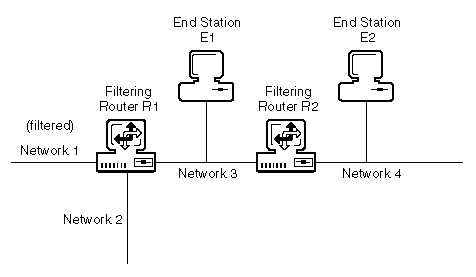

  |
Outgoing routing information filters limit routing information advertised by a router to its neighboring routers. When these filters are enabled on a router, only the allowed routes are advertised to each neighboring router. This hides specified routes from some routers and from certain parts of the network.
A typical outgoing routing information filter consists of the route to the destination network and the interface through which filtered advertisements of the route are sent. The filters affect all routers on the network to which this interface connects.
Outgoing routing information filters might not affect whether the end stations that are on the same LAN segment as the filtering router can access the filtered routes. Because these filters only keep from advertising filtered routes to other routers but do not affect the filtering router's routing table, the filtering router delivers all packets that it receives as destined for filtered routes.
End stations at least one router away usually cannot access networks with routes that are filtered out.
In addition to being able to filter by interface, you can also filter on a WAN circuit. You can assign filters with specific circuit information, including remote system ID, remote DTE address, and DLCI number. If the specific router is connected by the specified circuit information in the filter, then the filter is applied. Filtering on circuits is supported for X.25, ATM, frame relay, and PPP.
Figure 1 shows two networks; the route for one network has been filtered.
Figure 1
Outgoing RIP Filters
The route to Network 1 is filtered out in Router R1's advertisement to Network 3. If End Station E2 sends a packet to Network 1, Router R2 drops that packet because it does not have a route. If End Station E1 sends a packet to Network 1, Router R1 forwards it because it does have a route. End Station E1 can send a packet to Network 1 only if it has a route to that network. End station E2 can see only Networks 2, 3, and 4. End station E1 can see both Networks 1 and 2.
When IPX is used, route information filters affect both clients and routers. A client will make a route request that passes through the same filters as for the routinely transmitted route information. However, if a client is attached locally to a router that is performing outbound route information filtering and the client is using software that can use static routing, the client can send packets to Network 1 through Router R1 because R1 knows about Network 1 in its routing tables. If only standard IPX route lookups are done (true for a majority of sites), a path to the filtered networks is not possible.
  |